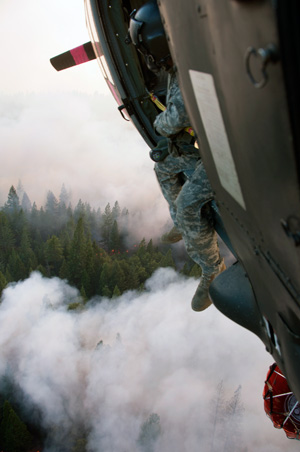
Last Wednesday, I traveled to San Francisco to attend a conference for work. My colleague, who traveled separately, showed me photos he had taken on his flight. The photos were of the fire currently burning in Yosemite National Park, bright and jagged slashes of orange and red against the night backdrop. All from 35,000 feet. He said, in a conflicted voice, that it was beautiful to see them from above.
The Yosemite fire has put San Francisco on alert for damage to the power grid and issues with the water supply, as the fire is currently four miles from the city’s main reservoir. Thousands of homes around the fire itself are in danger, and hundreds of people have been evacuated. Vermont has mud season; the West has fire season. This year, however, with the mandatory agency budget cuts implemented by sequestration, the danger of the fire season is exacerbated.
The U.S. Department of Agriculture (USDA) total estimated budget from direct appropriations for fiscal year 2013 is approximately $140 billion. Of that, the U.S. Forest Service received $5.5 billion, of which it allocated $2.7 billion to Wildland Fire Management, which includes the preparedness, suppression and removal of hazardous fuels programs. In March of this year, however, the Forest Service was still unsure of the final amount that would be available to allocate to actually fighting wildfires. Sequestration removed $115 million from the fire suppression line-item and diminished the wildfire reserve fund by more than $100 million. These cuts led to the removal of around 500 firefighters and 50 engines.

The Forest Service has already spent approximately $1 billion this year on wildfire suppression, even though the number of fires and the acreage burned are under the 10-year average. The roughly 32,000 fires, however, have burned for much longer, and many of the 3.4 million acres affected have been close to the wildland-urban interface. As a result, more money and resources have been needed to battle these blazes. And now, with only a fraction of the Yosemite fire contained, the Forest Service announced that its allocated funds to fight wildfires have been nearly exhausted.
With only $50 million left in the wildfire suppression line-item, Forest Service Chief Tom Tidwell is having to halt spending on restoration programs, employee travel, hiring and overtime to draw off the necessary funds to continue fighting wildfires. The $600 million needed will prevent the Forest Service from taking proactive steps to prevent future fires and decrease restoration efforts in previously fire-devastated areas.
This intra-agency money shifting, known as “fire borrowing,” while not new, has increased with the cutting of overall agency budgets. Calls for the return of funding necessary to fight current fires and prevent future ones still require congressional action, but current budget negotiations appear to be leading towards a continuing resolution with sequester-level spending rather than including additional appropriated funds.
The policy aim of preventing fires and the mission to fight currently burning ones are running up against the wall of politics. The reality is that fires in the West continue to burn, and the Forest Service must find the funds to fight them from somewhere, leading to the detriment of future fire prevention.
Concern about the state of fire funding has led American Forests to join a broad coalition of conservation, timber, recreation, sportsmen and employer groups asking Congress to provide immediate funding to support firefighters, ensure adequate funding in the fiscal year 2014 budget for wildfire suppression and implement a solution to continuing fire suppression shortfalls. Read more about this issue and efforts in our Newsroom.